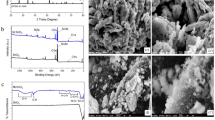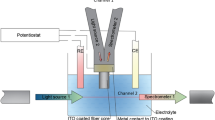Abstract
A novel fiber-optic evanescent wave sensor (FOEWS) for O2 detection based on [Ru(bpy)3]2+-doped hybrid fluorinated ORMOSILs (organically modified silicates) has been developed. The sensing element was fabricated by dip-coating the optical fiber with [Ru(bpy)3]2+-doped hybrid fluorinated ORMOSILs composed of n-propyltrimethoxysilane (n-propyl-TriMOS) and 3, 3, 3-trifluoropropyltrimethoxysilane (TFP–TriMOS). Fluorophores of [Ru(bpy)3]2+ were excited by the evanescent wave field produced on the fiber core surface and the emission fluorescence was quenched by O2. Spectroscopic properties have been characterized by FTIR and UV–VIS absorption measurements. By using the presented hybrid fluorinated ORMOSILs, which enhances the coating surface hydrophobicity, the quenching response is increased. The sensitivity of the sensor is 7.5, which is quantified in terms of the ratio I N2/I O2 (I N2 and I O2 represent the fluorescence intensities in pure N2 and pure O2 environments, respectively). The limit of detection (L.O.D.) is 0.01% (3σ) and the response time is about 1 s. Meanwhile, the proposed FOEWS has the advantages of easy fabrication, low cost, fast response and suitable sensitivity for oxygen monitoring using a cheap blue LED as light source and coupling a miniature PMT detector directly to the optical fiber probe.






Similar content being viewed by others
References
Demas JN, Degraff BA, Coleman PB (1999) Oxygen sensors based on luminescence quenching. Anal Chem 71:793A–800A
Tsukada K, Sakai S, Hase K, Minamitani H (2003) Development of catheter type optical oxygen sensor and applications to bioinstrumentation. Biosens Bioelectron 18:1439–1445
VanderDonckt E, Camerman B, Herne R, Vandeloise R (1996) Fiber-optic oxygen sensor based on luminescence quenching of a Pt(II) complex embedded in polymer matrices. Sens Actuators B: Chem 32:121–127
Lakowicz JR (1999) Principles of fluorescence spectroscopy, 2nd edn. Kluwer Academic/Plenum, New York
Xu H, Aylott JW, Kopelman R, Miller TJ (2001) M. A. Philbert, A real-time ratiometric method for the determination of molecular oxygen inside living cells using sol−gel-based spherical optical nanosensors with applications to rat C6 glioma. Anal Chem 73:4124–4133
Chan MA, Lam SK, Lo D (2002) Characterization of erythrosin B-doped sol-gel materials for oxygen sensing in aqueous solutions. J Fluoresc 12:327–332
McDonagh C, Kolle C, McEvoy AK, Dowling DL, Cafolla AA, Cullen SJ, MacCraith BD (2001) Phase fluorometric dissolved oxygen sensor. Sens Actuators B: Chem 74:124–130
Choi MMF, Xiao D (2000) Single standard calibration for an optical oxygen sensor based on luminescence quenching of a ruthenium complex. Anal Chim Acta 403:57–65
Malins C, Fanni S, Glever HG, Vos JG, MacCraith BD (1999) The preparation of a sol–gel glass oxygen sensor incorporating a covalently bound fluorescent dye. Anal Commun 36:3–4
Wolfbeis OS, Oehme I, Papkovskaya N, Klimant I (2000) Sol–gel based glucose biosensors employing optical oxygen transducers, and a method for compensating for variable oxygen background. Biosens Bioelectron 15:69–76
Dunbar RA, Jordan JD, Bright FV (1996) Development of chemical sensing platforms based on sol−gel-derived thin films: origin of film age vs performance trade-offs. Anal Chem 68:604–610
MacCraith BD, McDonagh C (2002) Enhanced fluorescence sensing using sol-gel materials. J Fluoresc 12:333–342
Kneas KA, Xu W, Demas JN, DeGraff BA, Zipp AP (1998) Luminescence-based oxygen sensors: ReL(CO)3Cl and ReL(CO)3CN complexes on copolymer supports. J Fluoresc 8:295–300
Tang Y, Tehan EC, Tao Z, Bright FV (2003) Sol−gel-derived sensor materials that yield linear calibration plots, high sensitivity, and long-term stability. Anal Chem 75:2407–2413
Koo YEL, Cao Y, Kopelman R, Koo SM, Brasuel M, Philbert MA (2004) Real-time measurements of dissolved oxygen inside live cells by organically modified silicate fluorescent nanosensors. Anal Chem 76:2498–2505
Campostrini R, Ischia M, Carturan G (2002) Sol-gel synthesis and pyrolysis study of oxyfluoride silica gels. J Sol-Gel Sci Technol 23:107–117
Atkins GR, Charters RB (2003) Optical properties of highly fluorinated and photosensitive organically-modified silica films for integrated optics. J Sol–Gel SciTechnol 26:919–923
Bukowski RM, Ciriminna R, Pagliaro M, Bright FV (2005) High-performance quenchometric oxygen sensors based on fluorinated xerogels doped with [Ru(dpp)3]2+. Anal Chem 77:2670–2672
Chu CS, Lo YL (2008) Fiber-optic carbon dioxide sensor based on fluorinated xerogels doped with HPTS. Sens Actuators B: Chem 129:120–125
Chu CS, Lo YL (2007) High-performance fiber-optic oxygen sensors based on fluorinated xerogels doped with Pt(II) complexes. Sens Actuators B: Chem 124:376–382
Busse S, Scheumann V, Menges B, Mittler S (2002) Sensitivity studies for specific binding reactions using the biotin/streptavidin system by evanescent optical methods. Biosens Bioelectron 17:704–710
Ge Z, Brown CW, Sun L, Yang SC (1993) Fiber-optic pH sensor based on evanescent wave absorption spectroscopy. Anal Chem 65:2335–2338
Keller BK, DeGrandpre MD, Palmer CP (2007) Waveguiding properties of fiber-optic capillaries for chemical sensing applications. Sens Actuators B: Chem 125:360–371
Vogt F, Karlowatz M, Jakusch M, Mizaikoff B (2003) The automated sample preparation system MixMaster for investigation of volatile organic compounds with mid-infrared evanescent wave spectroscopy. Analyst 128:397–403
Everest MA, Black VM, Haehlen AS, Haveman GA, Kliewer CJ, Neill HA (2006) Hemoglobin adsorption to silica monitored with polarization-dependent evanescent-wave cavity ring-down spectroscopy. J Phys Chem B 110:19461–19468
Kumar PS, Lee ST, Vallabhan CPG, Nampoori VPN, Radhakrishnan P (2002) Design and development of an LED based fiber optic evanescent wave sensor for simultaneous detection of chromium and nitrite traces in water. Opt Commun 214:25–30
Harrick NJ (1967) Internal reflection spectroscopy. Wiley, New York
Yariv A (1989) Quantum electronics, 3rd edn. Wiley, New York, pp 640–649
Colthup NB (1964) Introduction to infrared and Raman spectroscopy. Academic, New York
Lamber JB, Shurvell HF, Lightner DA, Cooks RG (1998) Organic structural analysis. Prentice Hall, London
Acknowledgements
This work was supported by the Chinese Academy of Sciences, Grant No. KZCX1-YW-14-3, and was partly supported by the Ministry of Science and Technology of China, Grant No.2008AA09Z110.
Author information
Authors and Affiliations
Corresponding author
Rights and permissions
About this article
Cite this article
Xiong, Y., Zhu, D., Chen, S. et al. A Fiber-Optic Evanescent Wave O2 Sensor Based on Ru(II)-Doped Fluorinated ORMOSILs. J Fluoresc 20, 269–274 (2010). https://doi.org/10.1007/s10895-009-0550-3
Received:
Accepted:
Published:
Issue Date:
DOI: https://doi.org/10.1007/s10895-009-0550-3




